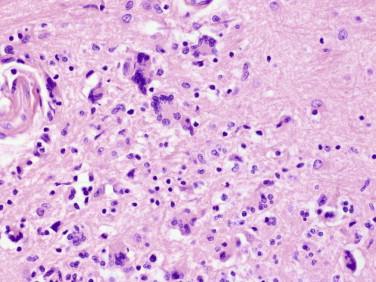Physical Address
304 North Cardinal St.
Dorchester Center, MA 02124
Neurologic complications directly attributable to primary infection of the CNS by human immunodeficiency virus-1 (HIV-1)
Virus enters CNS early, may remain subclinical
Neurologic complications develop in up to 50% of cases
Increased risk with lower CD4 counts and high CSF viral load
Primary infection: meningitis (more common), meningoencephalitis
Affects 10% to 20% of patients during acute infection
Usually asymptomatic
HIV-1 RNA detectable in blood/CSF
Symptomatic infection with meningeal signs, dementia, seizures, cranial nerve deficits (especially CN VII)
Giant cell encephalitis/leukoencephalopathy
Advanced disease associated with AIDS dementia complex (ADC)
Dysfunction leads to neurocognitive deficits and ultimately dementia
Vacuolar myelopathy
Most common HIV-associated chronic myelopathy
Seen in advanced disease (in <10% patients during era of highly active antiretroviral therapy [HAART])
Often overshadowed by concomitant illnesses
Weakness, stiff limbs, sensory deficits, sphincter dysfunction
Initiation timing of HAART is an ongoing debate
Meningitis may remain asymptomatic for years
Dementia severity may be correlated to number of infected versus noninfected microglia
Symmetric atrophy with periventricular, deep white matter low attenuation
Encephalitis/encephalopathy: frontal/temporal cortical atrophy +/− ventriculomegaly
Deep white matter: poorly defined grayish hue
Meningitis with mild lymphocytic infiltrates and scanty perivascular inflammation
Giant cell (HIV) encephalitis
Mainly affects subcortical white matter, thalamic nuclei, brain stem
Pericapillary aggregates of multinucleated giant cells having generous or scanty cytoplasm; giant cells contain the virus
Microglial nodules
Perivascular lymphocyte cuffing
Reactive vascular endothelial cells
Leukoencephalopathy
Diffuse demyelination/gliosis
Infiltrating macrophages, multinucleated giant cells
Microglial activation
Vacuolar myelopathy
Vacuolar changes and demyelination affecting posterior columns and lateral corticospinal tracts
GFAP: highlights gliosis
CD68, CD163, HAM56 highlight macrophages, giant cells, microglia
CNS drug and toxin effects
Psychiatric
Infections
Neurodegenerative and demyelinating diseases
Vascular diseases

A late complication of HIV/AIDS resulting in demyelination and vacuolation of spinal cord white matter; a diagnosis of exclusion
Become a Clinical Tree membership for Full access and enjoy Unlimited articles
If you are a member. Log in here